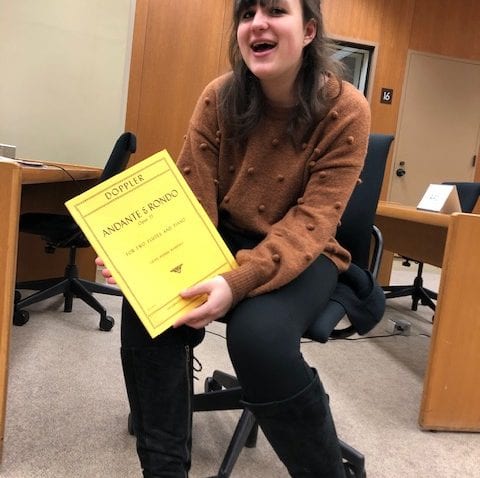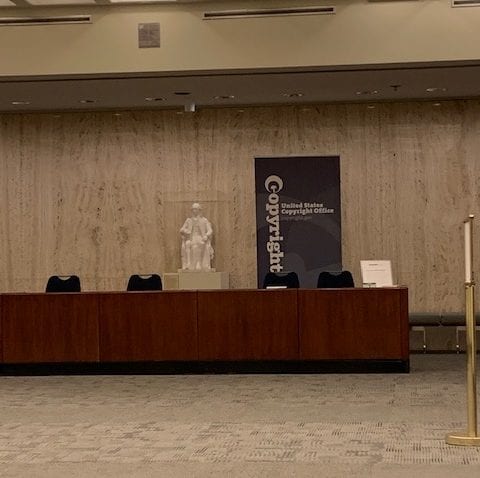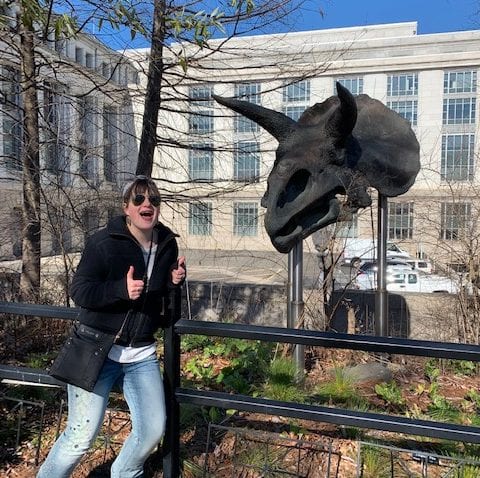
Saying goodbye across metro platforms.
The arts are powerful. Of course, I knew this before coming to Washington DC. I, myself, am an artist and musician. The arts have been a driving force in my own personal growth and development prior to this course. So, I was beyond excited to come to DC to study the relationship between the arts and democracy this interim and am so glad that I went. The opportunity to be a first-hand witness to the exchanges and government inner-workings that establish the relationships between the arts and democracy has affirmed how valuable my short time in Washington DC has been. To be able to learn in an environment that we are learning and reading about is a surreal experience. For example, reading about Black Broadway and the riots of the 1960s and then going on the Attucks Adams tour of Black Broadway and U Street (this tour took us around areas that were strongly affected by the riots) is a truly powerful and unique experience.
Professor Epstein and Alyssa Melby put together a course that challenged any preconceived ideas we might have had about the arts’ relationship with democracy. As students, learning alongside our teachers in an environment that is relatively unfamiliar has a powerful effect on what we can take away from the course. Every community partner that we engaged with provided significant insight into a variety of different areas of policy pertaining to the arts.
The relationship between the arts and democracy is an intricate web, more elaborate than one might assume. Every arts institution takes on a different role within the democratic system they are all inherently apart of. The National Endowment for the Arts (NEA) or the Smithsonian museums- institutions most obviously related to the government- face different challenges than other institutions like the Art Museum of the Americas or the District Community Playback theater company. Each meeting with these community partners was a chance for us to truly understand what their role is as an institution that is affected by our political system. Our meeting with the NEA entailed discussion of accessibility and more prominently, a discussion of what the Endowment does for the artists of America. They award grants to artists and their projects. They award these grants in a way that allows as many voices as possible to speak through art. Yet, contemporary social justice projects are often rendered ineligible for a grant. While the NEA recognizes the importance of these projects, they must maintain a face of neutrality in favor of faith and trust in the slow processes of change that are inevitable within the political system. Many other institutions we met with must maintain projects that fit within the qualifications of NEA grants. In contrast, artists like those who work with the District Community Playback theater company or the Halcyon Arts Lab focus their work on the social justice issues they are personally passionate about. They maintain goals that benefit local communities or their immediate audiences. As one can see from these examples, each community partner we met with maintains their own nuanced systems for productivity and success. Each member of the arts community in DC has a unique role in the larger community that would not function the same without them. The arts need support and funding, but they also need to be accessible to touch the lives of everyone in the community around us. The interactions between the US political system and the community of artists and art institutions are high-functioning and successful in achieving many of the goals that they set for themselves.

National Endowment for the Arts
There are so many opportunities available in Washington for the country’s constituents to share their beliefs and opinions with policymakers and officials. Anyone can participate in advocating for what they are most passionate about. Americans for the Arts (AFTA) is an advocacy organization that has a plethora of tools available for anyone to use to advocate for the arts. However, you do not have to participate through an organization like this to take advantage of how easy it is to access our elected officials responsible for policy. Many different issues take primary consideration for our government authorities. It is up to us as the constituents to decide what our priorities are.

Calling up one of my favorite pieces of music at the Library of Congress.
In the spirit of taking advantage of the access to resources and public offices, the day before we left, I headed over to the Library of Congress with some classmates to finalize some research for our final project. My project proposal was inspired by a copyright lecture I attended earlier in the trip. I walked into the Copyright Office to see if I could fill in some holes in my research. After some waiting, I was able to make it past the front desk and meet with a senior information specialist. She gave me many materials that aren’t directly available through their website or other resources. Earlier in the trip we met with the office of Tina Smith and Angie Craig. And, as I am sure you have seen, many class members met with senator and presidential candidate Amy Klobuchar! These meetings and opportunities just speak to the level of engagement an individual can have with the officials and offices that make decisions on behalf them: they want to hear your voice, so don’t hesitate to share it with them. My role as a constituent is to make my voice heard if I want something to change. If someone doesn’t know I desire change, then nothing is going to change.

At the Copyright panel
Washington DC is inhabited by a diverse group of artists. Each has their own specific goals and focuses that contribute to the country’s creative economy. I am most definitely still a proponent of the arts. Without the arts, my life would not be as enjoyable as it is. Leaving DC, much of my confidence is restored in our government system’s dedication to the arts. An idea that we kept entertaining as a class is that the system isn’t perfect, but that is okay. I don’t mean to comment on the current political atmosphere, rather, I mean to say that the place of arts in the eyes of our federal government isn’t as bad as I originally anticipated. The system is still imperfect. Threats of censorship and reduced funding still linger in the fog of the current political climate, but we are doing a surprisingly good job of maintaining and recognizing the cultural significance of the arts and making others aware of it.
As I sit here reflecting in one Washington on another, I can say that the link between the arts and democracy is complex and exciting. Democracy and the Arts in Washington DC has allowed me to come to this conclusion. This course has exposed us not only to this intricate system, but also the different ways we can function as a part of it. Not only have I been blown away by the opportunity to see so many performances and meet with so many people, but I have also been surprised by the friendships and relationships I have cultivated along the way with my classmates and our two fabulous program leaders. This course was truly exceptional because it pushed us outside of what is comfortable to encounter new perspectives and entertain ideas contrary to our own. I will carry this experience with me for the rest of my life, and for that I am truly grateful. Take a moment to read about my other experiences and the experiences of my classmates. Each of us used our own identities and unique experiences to make our discussions and disagreements much more powerful.
To close, I want to say that I love learning. I love the arts. And, I have come to love Washington DC. From dinosaurs to winning the sleep competition to midnight crepe runs and 9:00 pm office hour meetings with Professor Epstein, each of these small details contributed to the fantastic time I had in DC. The arts are alive and well and so are we. As we return home before starting a new semester with a better understanding of the political system we are apart of, it is safe to say we will carry this knowledge with us and influence how we decide to participate and take advantage of the arts in our world.

Thumbs up for dinosaurs
